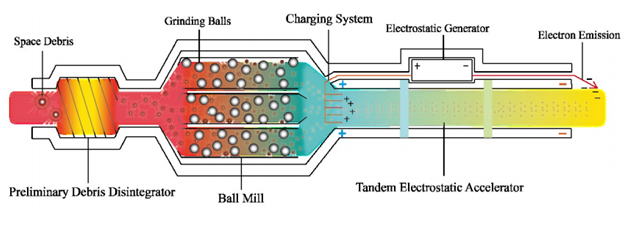Chinese Researchers Propose A Spacecraft That is Fueled by Space Junk.
Solving two problems with one action is an attractive prospect. There is an old folk saying that covers this idea. "Kill two birds with one stone." It often save money, time and effort over solving two problems independently. The junk in Earth orbit consisting of debris from launches and dead satellites is building up to the point where it may become more difficult to launch space missions. It is estimated that there are over half a million pieces of debris in Earth orbit. Pieces of this debris could be traveling at over seventeen thousand miles per hour. Existing satellites in near Earth orbit are increasingly at risk from damage by space junk as are launches of satellites and spacecraft. Fuel is a major expense in launch a satellite or spacecraft into orbit. Recently, there has been a proposal of a way to use space junk to fuel rockets.
Chinese researchers at Tsinghua University in Beijing have developed a plan to construct a spacecraft that can rove around collecting space junk and converting it into fuel. This solves one of the biggest problems with previous proposals to clean up space junk. They all required huge amounts of fuel to travel around finding and disposing of the junk.
The new Chinese space garbage collector will find capture space debris a net or a claw. One limitation of the system is that it can only capture and reduce debris that is more than four inches in size. Various systems to pulverizing the debris were considered and it was ultimately decided that the best choice for irregular sized and shaped pieces would be a mechanical process. Bigger pieces would be broken up first into smaller fragment. The small fragments would be ground up in a ball mill or blasted with a laser to produce a fine powder.
The engine for the craft would be based on the NASA Variable Specific Impulse Magnetoplasma Rocket (VASIMR) design. The VASIMR is "an open-ended, RF heated, magnetic mirror-like" plasma device. The powdered debris will be heated by the engine and turned into a plasma. The plasma can then be expelled to propel the craft. The designers suggest that nuclear power or solar power could be used to generate the heat to create the plasma. Critics raise the question of whether either of these two sources would be sufficient to operate the proposed craft. There is also the issue of the safety of having a nuclear powered spacecraft orbiting the Earth.
The Chinese research team also suggests that it might be possible to utilize their system for exploration of asteroids. A spacecraft could rendezvous with an asteroid and mine it to create the powder needed for fuel. This would allow much longer missions of exploration. These is also the possibility of creating fuel from asteroids to assist in carrying out missions to other planets.
Given that serious problem posed by the growing cloud of space debris surrounding out planet, the self-fueling garbage collecting spacecraft proposed by the Chinese researchers is welcome entry into the competition to find a fast and economical way to clear the junk out of Earth orbit.
Space junk eating engine:
![]()
